The MSI Titan GT77 Review: Desktop-Class Core i9-12900HX Tested
by Brett Howse on September 1, 2022 10:00 AM EST- Posted in
- Laptops
- Intel
- MSI
- Alder Lake
- Alder Lake-HX
Display Accuracy
While most of the MSI laptop range offer display choices, the MSI Titan GT77 12UHS is only available at retail with a 3840x2160 120 Hz UHD panel. This itself would typically be unremarkable, however underscoring the engineering sample nature of the laptop that Intel sent over, our test unit is equipped with an entirely different panel: a 1920x1080 360 Hz display, seemingly the same one used in the Raider GE76. As a result the display in our evaluation unit isn't the display you'll find at retail.
Every so often we get discrepencies like this with engineering sample hardware, and in most cases it's due to a last-minute change in plans for retail hardware. In this case, we suspect that between assembling their engineering samples and retail hardware, MSI opted to axe the 1080p/360Hz version of the laptop and only offer a 4K/120Hz version. This, if nothing else, underscores how swiftly the laptop market can move, especially for low volume hardware like desktop-class laptops.
We have seen 360Hz displays on other high-end laptops (including the aforementioned Raider), as the lower resolution panels are a favorite of eSports gamers. But the UHD option makes more sense in the flagship model for most people, and the RTX 3080L Ti is really one of the few graphics options that allows this to work on a gaming notebook.
In any case, along with their obvious focus in high-performance designs, MSI is also one of the few companies to focus on display accuracy. To that end. they include a great utility called MSI True Color which lets you set the display color to several different modes, as well as customize the gamma, color, and more.
Unfortunately, there is a bug in our engineering sample with the latest Intel graphics driver and True Color which causes the gamma to get completely messed up. When you launch True Color, it lets you know about this, and how to reinstall the older driver. The incorrect gamma settings cause the screen to become washed out. This appears to be an issue across a wide range of devices, so if this happens to you MSI has a support article here:
https://us.msi.com/faq/faq-7518
The instructions detail going into safe mode and removing the Intel driver, then installing a new version. That did not work on this review unit so it will likely need to be reset after the review.
True Color also supports built-in calibration if you have a supported Colorimeter. The process is very quick and easy. Because the gamma was so far out with the driver issue noted above, it seemed like a good change to test the calibration.
You basically plug in a supported colorimeter and hit play, and in about five minutes the system creates a new color profile and applies it. It did help significantly with the gamma issue, but let’s see how it did on actually calibrating the display.
To test display accuracy we use Portrait Display’s Calman software suite with a custom workflow. For brightness and contrast readings, the X-Rite i1Display Pro colorimeter is used. For color accuracy testing, the X-Rite i1Pro2 spectrophotometer is connected.
Brightness and Contrast

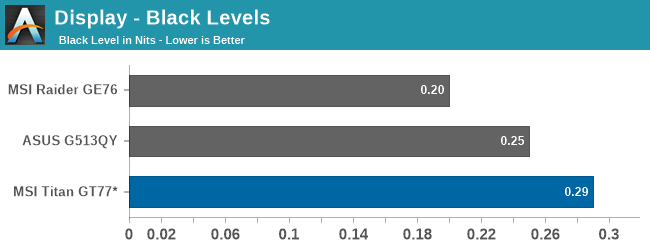
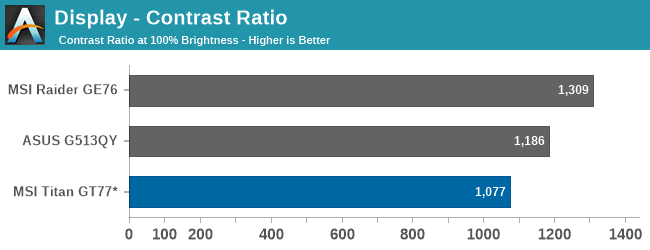
At around 317 nits at 100% brightness, the Titan GT77 is good for most scenarios where you would expect it to be used. If your location is in bright sunlight, it may not be enough, but for a gaming notebook the display is above average for brightness. The display goes down to 15.2 nits at 0%, which is a reasonable range.
The contrast ratio of 1077:1 is just average for the category. The Raider GE76 we tested was a bit better and has the same 17-inch 360 Hz display, but that one didn’t get as bright, so perhaps it is a bit of panel lottery.
Grayscale Accuracy
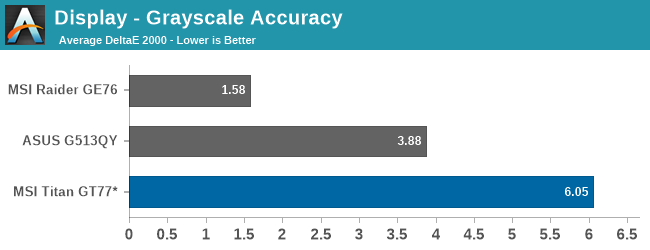
With the aforementioned graphics driver issues, it is unfortunate how far out the grayscale accuracy is even after running through the True Color built-in calibration sequence. It did help bring the overall gamma closer to the 2.2 power expected of sRGB, but such a short calibration sequence was not able to achieve accurate gamma across the entire 0-100% range.
Gamut Accuracy

The Gamut test measures the primary and secondary colors at their 100% levels, and here the calibration did seem to help. Although the accuracy is nowhere near the excellent accuracy achieved by the Raider GE76, 2.57 would be considered accurate.
Saturation
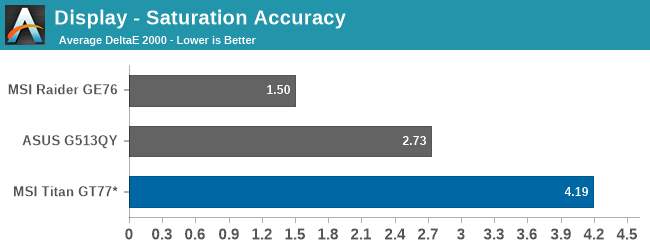
The saturation sweeps mimic the gamut tests, but test the primary and secondary color levels across the entire 0-100% range in 4-bit steps. The built-in calibration tool was not able to cover all of the range and provide proper correction
Gretag Macbeth
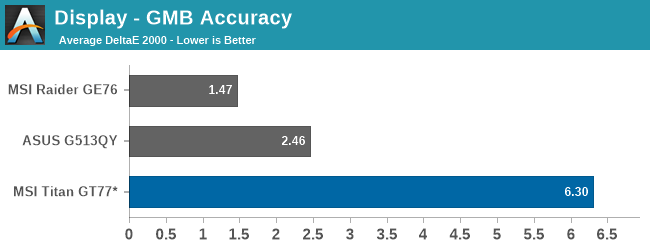
The Gretag Macbeth workflow tests colors from across the range rather than just the primary and secondary colors. Here the results were poor, with the built-in calibration not doing any correction outside of the primary and secondary sweeps.
Display Conclusion
As this particular configuration of Titan GT77, in particular the display choice, will not be available at retail, this is not a representitive result and certainly not in-line with what we normally see from MSI laptops. It was a good chance to see how well the True Color software calibration worked, and it worked pretty much as expected. It helps, but it certainly is not able to replicate a professional calibration suite like the Calman suite we use.
The calibration sequence that is built-in to the True Color utility does a reasonable job and the difference before and after running it was very apparent, but if you have ever done any color calibration on a display you will know that a less than five-minute routine is only going to be able to achieve so much. It helped, but it was not able to correct everything.


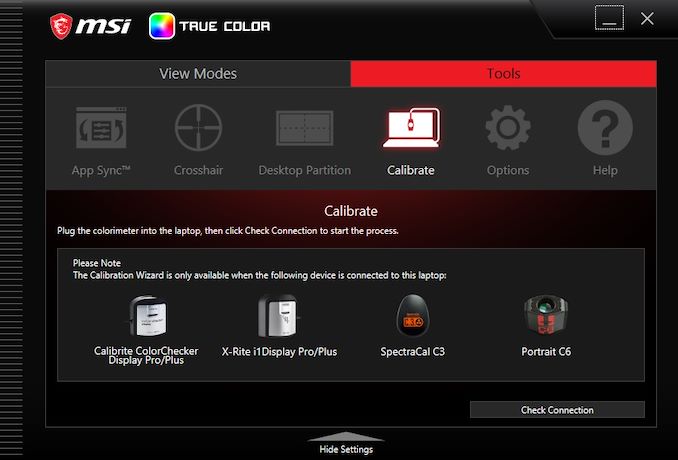












25 Comments
View All Comments
IBM760XL - Friday, September 2, 2022 - link
This is how I know my 2018 MSI has poor battery life: a hulking DTR like this has twice the battery life, and my laptop has never had much more battery life than it does now.Props to MSI for finally putting a properly-sized battery in their laptop. But I'm also rather impressed that it can get over 6 hours of battery life in general. The rest of the specs are a bit overkill for what I need, but hopefully they've stopped putting 42 WHr batteries in their dGPU laptops in general. Or at least propagated their recent power efficiency improvements.
Now where's the all-AMD variant that gets battery life figures similar to that Asus? I want the Asus's hardware with the MSI's design.
garblah - Friday, September 2, 2022 - link
Why aren't 120hz OLED or 144hz OLED displays more common on high end gaming laptops? Who is hitting 240hz or 360! hz on a laptop. I can't imagine paying 3000 dollars for a screen with the ubiquitous grey "blacks" of an IPS panel.iranterres - Sunday, September 4, 2022 - link
I gotta love this new batch of stoves that Intel's put to market LOL.Oxford Guy - Monday, September 5, 2022 - link
Titanic tinnitus.snowdrop - Wednesday, September 7, 2022 - link
The multitasking testing only really shows that more threads (& more power) = better at multitasking which seems a bit obvious.The 12900HX is 24 threads (8P, 8E), the 12900HK is 20 threads (6P, 8E), and the 11980HK / 5900HX are both 16 threads so it's hard to discern architectural advantages from Alder Lake.
Adding a 12th gen part with a similar core count to the 11980HK / 5900HX like the 12600H (4P, 8E) or 12650H (6P, 4E) with 16 threads would make this comparison much more useful? Or possibly adding a test of the 12900HK limited to 16 threads by disabling the E cores (8P, 0E)?